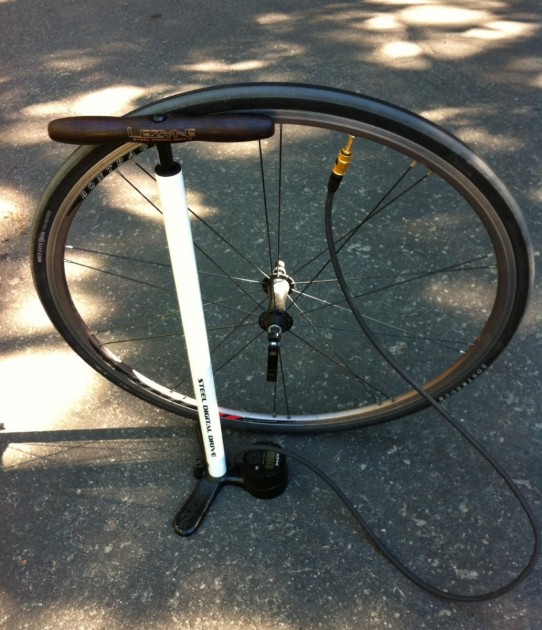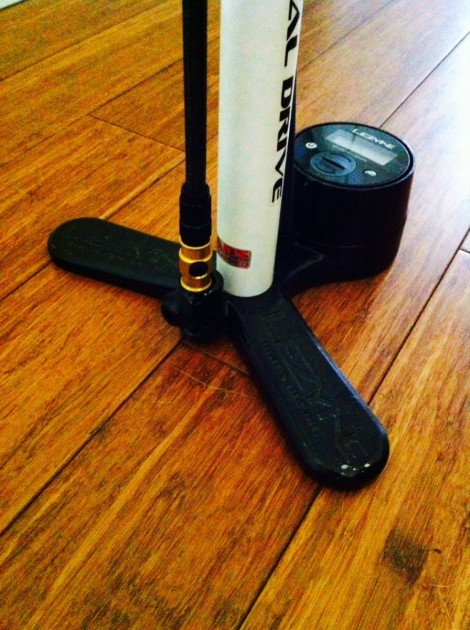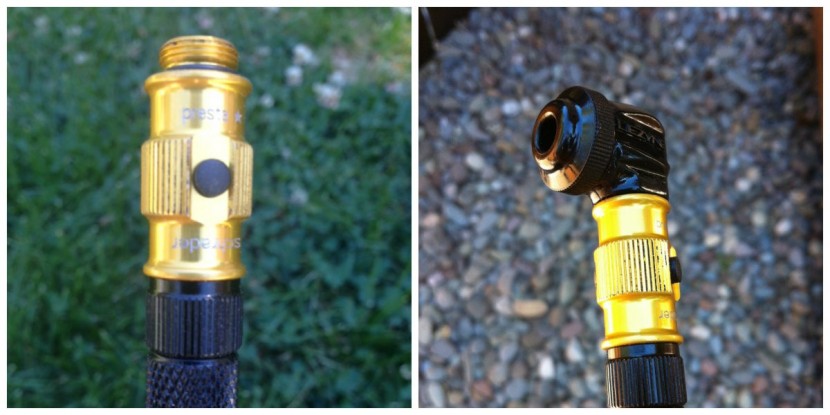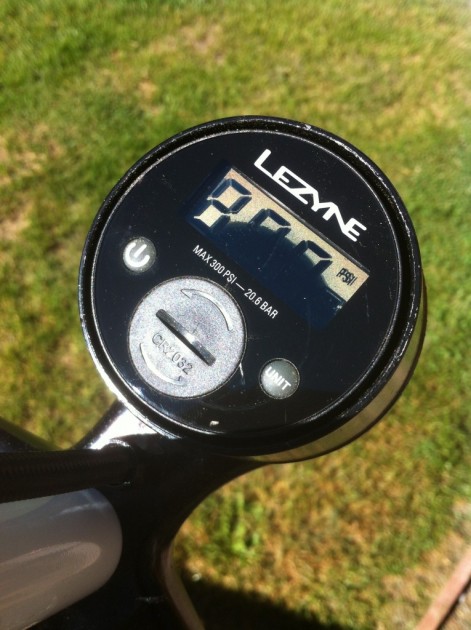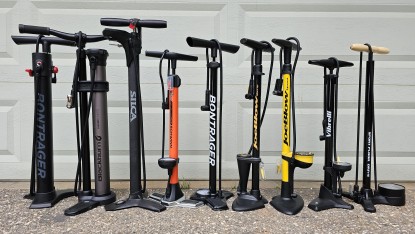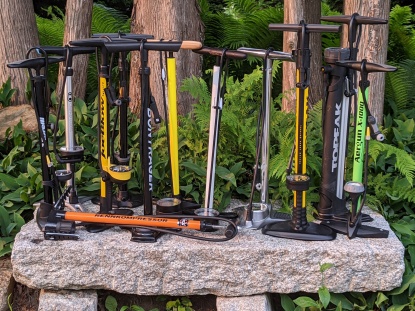Lezyne Steel Digital Drive Review
Our Verdict
Our Analysis and Test Results
For such a good looking pump, we were expecting a lot, especially given the steep price tag and reputation for quality that Lezyne has earned over the years. Maybe we got a lemon, but inflating tires with this pump kept us wondering, “Is this thing broken?”. When first attaching the flip-thread chuck onto a valve, we expected the digital gauge to read the current pressure inside the tire. It didn't. It took a few pumps to get the gauge to register and the pumping action, as described above, felt empty. We swapped around the o-rings inside the pump and experienced the same feeling. On the plus side, this pump scored well in our stability, gauge, and accuracy metrics, though the overall experience was underwhelming, especially given the high cost.
Stability
Standing in stark contrast to some of the fragile plastic bases of other models we tested, you could use the aluminum base of the Steel Digital Drive as a hammer. It shares the same dimensions and design of the Lezyne Steel Floor Drive but instead of an analog gauge, a digital gauge sits atop the front tripod leg. The back legs are 4 1/8 inches in length and just under 1 1/2 inches wide; the front leg (that holds the gauge) widens to 3 inches and provides a great deal of additional stability and surface area contact. Small rubber nodes sit in recesses at the distal end of each leg (two on the leg with the gauge) to provide traction on slick surfaces and also serve to protect delicate surfaces. The rubber pieces appear to be glued into the recesses, though one disappeared somewhere during our testing. On most surfaces, the pump performs unaffected, but pumping on fine hardwood floors might not be the best idea.
Ease of Attachment/Detachment
The high-pressure ABS (Air Bleed System) flip-thread chuck screws onto both Schrader and Presta valves; this was the only thread on air chuck in our test. In theory, a thread-on chuck will last longer than the seals of a press-on chuck that repeatedly press onto a valve stem. The possibility of the head-blowing off the valve stem during pumping is also eliminated. To accommodate different valve types, the distal anodized gold portion unthreads from the adjacent black coupling. The black coupling that the anodized gold ABS flip-thread chuck threads into spins freely at its attachment and is used to secure the chuck to the valve.
Initially we were threading the chuck onto valves, holding the golden chuck in the middle, between the two ends, where the bleed valve is located. It was extremely difficult to thread onto the valve without accidentally pushing the button. We soon realized our error and began threading it onto the valve, using the coupling that receives the chuck. While this aids in placing the valve on the threads, it isn't much help in getting it off. Using the coupling to unscrew the chuck from the valve will simply unscrew the chuck from the coupling, while accidentally hitting the ABS button (when unthreading properly by the chuck itself) is nearly unavoidable. Not a big deal for Presta valves because the ABS button does not actually release pressure from the tire, rather just from the hose to ease removal. Conversely, air will be released from the tire using the ABS button with a Schrader valve.
A Presta only, press on speed chuck is included with the pump and threads into the Presta end of the flip-thread chuck. Outside of our testing, we mostly used the pump with Presta valves and preferred the faster, easier attachment of the speed chuck. The speed chuck simply presses onto a Presta valve; there is no locking lever to secure it to the valve but surprisingly it performed flawlessly. When used with tubeless tires, threading and unthreading the flip-thread chuck onto the valve often caused the valve stem to sink within the rim, sometimes allowing air to escape from around the valve. A properly seated valve stem is an essential component of a tubeless tire system and we felt the flip-thread chuck compromised the seal.
Gauge
The digital gauge on this pump is pretty slick and super easy to operate. There are two buttons; one to turn it on and another that toggles between psi and bar. This being the United States, we're guessing 99 percent of people don't state their pressure readings in bar. So basically, there's a power button. Simple enough. The digital display screen is 1 1/2 inches long and 5/8 inches high; it reads in whole numbers, meaning no decimal readings are given. When exposed to direct sunlight on hot days, the display will form a black spot that will obscure the reading. Removing the display from the sunlight allowed the spot to recede and the display returned to its normal appearance and function. Prolonged, continuous exposure could potentially have long-term damaging effects on the digital display, but this did not occur during the timeframe of our test.
We submerged the gauge in shallow water and soaked it thoroughly with a hose. Our display continued to work and never had any issues with condensation beneath the display lens. The display will read pressures up to 300 psi - the highest of any pump we tested by far.
Inflation Speed
This is a high-pressure pump that will probably be more attractive if you spend most of your time on a road bike. Mountain bikers would be better served with a big barrel, high volume pump. When we first used the pump on a tubeless mountain bike tire, we thought something was wrong with the pump. With the flip-thread chuck fully threaded onto the valve, we never noticed any noise indicating the valve was engaged and the digital display always read zero. The initial few strokes of the plunger were met with no resistance and a couple of additional pumps were required to even get a reading on the display and feel some resistance. With low-volume tires, “priming the pump” is essential. Even during pumping, it felt like every few pumps, the plunger would depress resistance free. This always occurred at lower pressures on tubeless mountain bike tires. A similar feel was also present with road bike tires.
“Priming the pump” was again necessary, requiring several effortless pumps to get a reading on the display. The best way to describe this feeling is comparing it to pumping without the head attached to anything. Once pressurized, the stroke of the pump felt effortless until the last few inches when it would abruptly encounter resistance. A call to Lezyne's customer service told us that we may have a bad o-ring. There are two o-rings; one at the base of the piston and another “floating” ring. We swapped those around and still experienced the same operation. This pump felt markedly different from any others in our test; whether faulty or not, this resulted in a much greater stroke count to inflate any given tire.
Accuracy
The Steel Digital drive gauge is claimed to be within a 3% accuracy range. Our findings were consistent with this claim, with confirmed readings never more than 1 psi above or below the gauge reading. Our batteries never wore out and the unit will shut itself down after a short period of non-use so as not to drain the battery. Some will likely find the digital gauge to be this pump's best, and most attractive, feature. Others may feel a digital gauge adds unnecessary complexity. As stated above, this is a high-pressure pump probably best suited to road biking. Despite this fact, we did like the digital gauge for use with high-volume, low-pressure mountain bike tires. The problem with most other gauges is that the working pressure ranges for such tires make use of such a small portion of the gauge. Reading a digital number takes away all the guesswork.
Best Applications
Roadies will love the high-pressure capabilities of this pump, although we can't think of any discipline in cycling that would come close to maxing out the 300 psi this pump is capable of. This pump proved to be very accurate and would be a good choice for those that are quite discerning about their tire pressure.
Value
At $90, this was the most expensive pump (without an accessory high-pressure chamber) for seating tubeless tires. There is a $30 difference between this pump and our Editors' Choice Lezyne Steel Floor Drive, which retails for $60. The price difference mainly seems to come from the digital gauge. The Digital Drive also features a braided high-pressure hose; while nice, it's of questionable necessity. We much preferred the ABS2 chuck over the flip-thread chuck because it bled air from the tires on Presta valves and was easier to use.
Conclusion
The “empty” feeling we experienced during pumping, whereby the plunger sunk repeatedly and un-resisted many times at the onset of pumping, left us underwhelmed with this pump's performance. It resulted in a far greater number of strokes to inflate every tire we tested. The flip-thread chuck is outperformed by the ABS2 chuck; the ABS2 can bleed air directly from the tire on both valve types and is also included on the Lezyne Steel Floor Drive. If you deal solely with Presta valves, you're most likely to just leave the slip-chuck on permanently.



